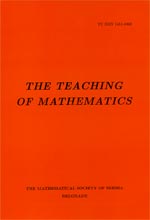
| Solving inequalities in primary school |
| Milosav M. Marjanović and Marijana Zeljić |
Abstract When sums and differences with a variable component are compared with a fixed number, simple inequalities suitable for solving in the set N of natural numbers are obtained. Solving of these inequalities bases upon the properties of such expressions to increase or decrease, depending on the change of values of their components. To establish the meaning of an inequality, children have to be stimulated to see it as a representation of a whole set of numerical relations, some of which are true and some false. Then, the search for those values of the variable component for which these relations are true is the procedure of solving an inequality. Thinking of prerequisite knowledge and skills for this procedure, some exercises have to be planed that will help children assimilate the meaning of some operative terms: expression, value of an expression, to take value, etc., as well as to instruct them in using first set-theoretical notations properly. Not counting general observations, the entire text of this paper resembles a concrete elaboration, appropriate for school practice. |
Keywords: Expression, Value of an expression, Variable summand (minuend) (subtrahend), Inequality, Set of solutions. |
Pages: 13$-$30 |
Volume IX , Issue 1 , 2006 |
